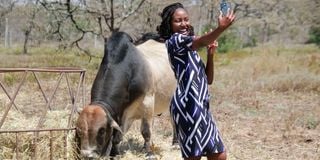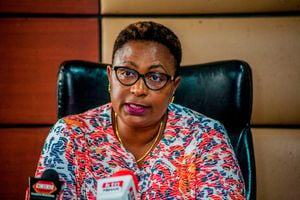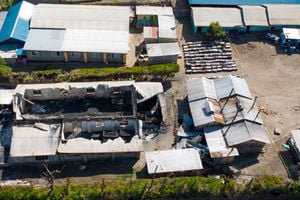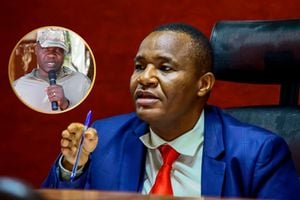Kenya, South Africa Boran cattle embryo export deal takes shape

Jacqui Mwangi takes a selfie next to a Boran bull at the Sirima Cattle Quarantine Centre within Ol Pejeta Conservancy in Laikipia County on September 14, 2023.
Kenya is to begin exporting thousands of Boran and Ankole cattle embryos to South Africa.
Scientists have already finalised the preparation of 1,353 Boran and 1,601 Ankole breed embryos at Sirima Cattle Quarantine Centre, Ol Pejeta Conservancy in Laikipia County.
The two breeds are in high demand across the continent, with the embryo export expected to cement the bilateral trade agreement inked between Kenya and South Africa a few months ago.
Sirima Cattle Quarantine Centre has been involved in biotechnology for more than 20 years. It works with Embryo Plus, a South African institute.
Embryo Plus Managing Director, Morne de la Rey, told the Seeds of Gold that the project would ensure the transfer of disease-free embryos and produce thousands of calves in South Africa.
“This is one of the largest embryo export consignments in the world. The project is important as it will improve ties between Kenya and South Africa,” Dr Morne said.

An animal health service provider inspects a bull at Sirima Cattle Quarantine centre inside Ol Pejeta Conservancy, Laikipia County, on September 13. The conservancy has the largest herd of purebred Boran cattle in Kenya.
The scientists and the Laikipia devolved government signed export permits before sealing the embryo flasks in readiness for their transfer to South Africa.
“I am proud because we can show the rest of the world that Africans can come up with such a large and complex project. This is the only cattle quarantine centre of embryo export in Africa,” Dr Morne added.
The 90,000-acre conservancy has 6,000 Boran cattle, which are usually selectively picked for embryo harvest.
It has an expansive pre-quarantine paddock where experts monitor the selected cattle for 21 days.
Centre manager, Eugene Gachii, says samples are collected from the animals and tested for brucellosis, foot and mouth, bovine TB, contagious bovine pleuropneumonia and other illnesses.
“Once the bulls are confirmed to be healthy, they are moved to the quarantine paddock where we start the process of embryo transfer,” Gachii said.
“We synchronise and superovulate the animals through artificial insemination. After seven days, we harvest the embryos and examine them for viability. They are then frozen in liquid nitrogen.”

Dr Morne de la Rey demonstrates how embroys are preserved in liquid nitrogen on September 14.
Once the embryos land in South Africa, they are placed in another quarantine centre before being implanted in surrogate mothers.
Boran is the most hardy cattle breed on the continent.
South Africa imported its first Boran embryos from Ol Pejeta in 1994 and the animal’s registered population has grown to at least 40,000.
Ol Pejeta Conservancy’s Agriculture consultant, Giles Prettejohn, said the demand for the breed in South Africa has been rising due to its resilience and quality meat.
“South Africans have discovered that Boran can be productive on natural pasture. It is thethe fastest growing breed there,” Prettejohn said.
“As the home of the breed, we must maintain our standards. Compared to South Africa, Kenya has fewer breeders of Boran. Fortunately, we have the best genes.”
Laikipia Livestock Chief Officer, Mary Gichuru, said the project would showcase Kenya as the country with one of the best cattle breeds on the planet.
“This should open the eyes of other county governments. They need to take part in improving their resources,” she says.
County Veterinary Services Director, Jackson Ncebere, participated in the entire project.
“This has been a long process but we are happy with the outcome. We are ready to partner with diverse stakeholders and explore the other local resources. We will improve the animal breeds found in Laikipia,” Dr Ncebere said.
Ol Pejeta Conservancy’s Livestock head, Adil Butt, said the aim of the project is to export disease-free cattle genetics.
“We used to move genetics by live exports. We realised that by doing that, we were losing the animal itself. Exporting genes ensures we remain with the producer,” Butt said.





